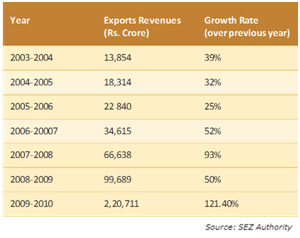| |
|
|
|
|
|
After India opened its economy, the policy makers came up with Special Economic Zones (SEZ) policy in 2000. This policy intended to make SEZs an engine for economic growth supported by quality infrastructure complemented by an attractive fiscal package, both at the Centre and the State level, with the minimum possible regulations.
|
|
|
| |
|
The SEZ Act formulated by the Government in 2005 along with the SEZ policy rules came into effect in February 2006 with its main objectives as:
|
| |
|
 |
generation of additional economic activity |
 |
promotion of exports of goods and services |
 |
promotion of investment from domestic and foreign sources |
 |
creation of employment opportunities |
 |
development of infrastructure facilities |
|
|
|
The establishment of SEZs has enabled India to increase its export revenues by huge margins across all sectors.
 Success of SEZs having been established, SEZs have relatively lagged in developing an innovation culture which is pertinent for building a robust electronics industry. This calls for unified clusters that comprise of innovation driven universities, incubation centers for budding technology firms, larger firms that can provide technical know-how – all within a singular campus for fostering innovation and manufacturing in electronics. There is an imperative need for development of not one, but many such clusters to encourage indigenous R&D and manufacturing in electronics. Creation of thematic clusters for developing new and innovative solutions in identified fast growing segments shall change the character of the Indian Electronics Industry. Success stories such as the Hsinchu Tech Park, Taiwan, Sofia Antipolis, France are evidences of the impact clusters can have in the development of an industry and a country’s economy. Success of SEZs having been established, SEZs have relatively lagged in developing an innovation culture which is pertinent for building a robust electronics industry. This calls for unified clusters that comprise of innovation driven universities, incubation centers for budding technology firms, larger firms that can provide technical know-how – all within a singular campus for fostering innovation and manufacturing in electronics. There is an imperative need for development of not one, but many such clusters to encourage indigenous R&D and manufacturing in electronics. Creation of thematic clusters for developing new and innovative solutions in identified fast growing segments shall change the character of the Indian Electronics Industry. Success stories such as the Hsinchu Tech Park, Taiwan, Sofia Antipolis, France are evidences of the impact clusters can have in the development of an industry and a country’s economy. |
Why Clusters can be Game Changers?
Clusters are home to a combination of organizations including academic institutions, start-ups, MNCs and other allied organizations all focused on the same sector of operation. By co-locating in the same region, companies benefit from access to the research minds at institutes for partnering in R&D. Further, by establishing all other common facilities needed for the industry such as testing facilities, standardization labs etc., all companies in the cluster can make use of the facilities. Moreover by making use of the expertise in the institutes and companies, centers of excellence in specific areas within the sector can be established for promoting next generation research, developing standards and conducting basic research. In India, the cluster approach has been quite successful in various industries such as locks, garments, diamond cutting etc.; however, it has not been attempted in the electronics industry. Setting up common centers of excellence in the cluster, can influence collaborative R&D as well. Additionally, once the formation of a cluster is initiated and a few companies set up their operations, the feeding industries to these companies will also move in their operations into the cluster, thereby aiding in the development of the ecosystem.
Recent Government incentives such as infrastructure support and incentives for setting up of Greenfield Electronics Manufacturing Clusters along with incentives for indigenous R&D are expected to trigger the creation of such clusters in the country and pave way for the Electronics Industry Growth. Vittal Innovation City, with its focused agenda on developing an integrated cluster for the electronics industry, is well poised to be chosen as a “Pilot Cluster” by the Government of India in its new policy to support manufacturing and innovation in electronics manufacturing. |
| |
|
|
| |
|
|
|